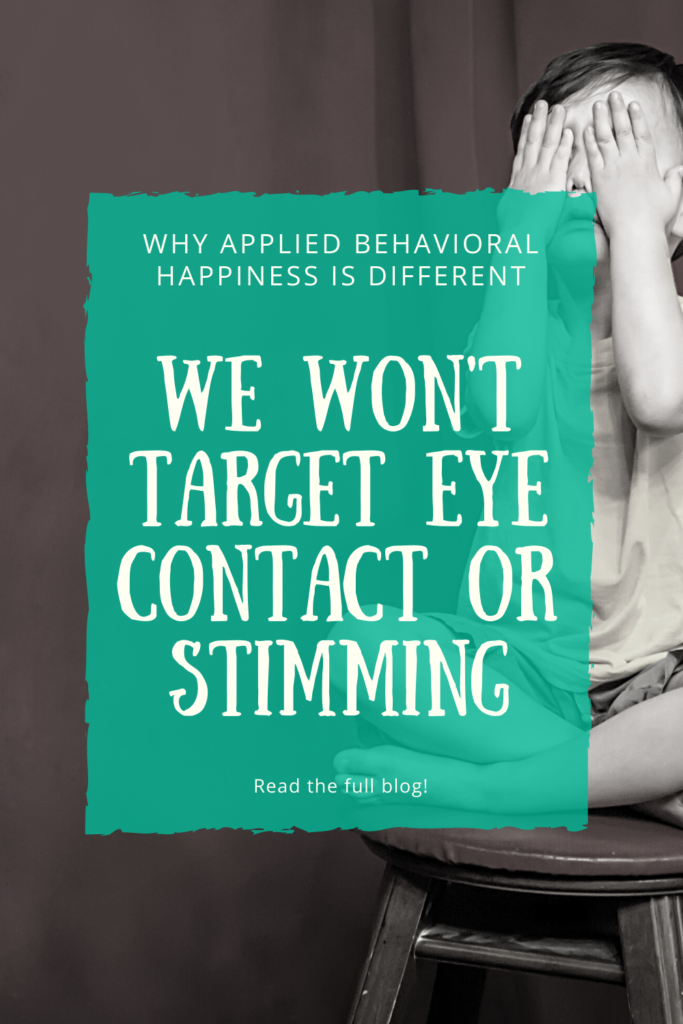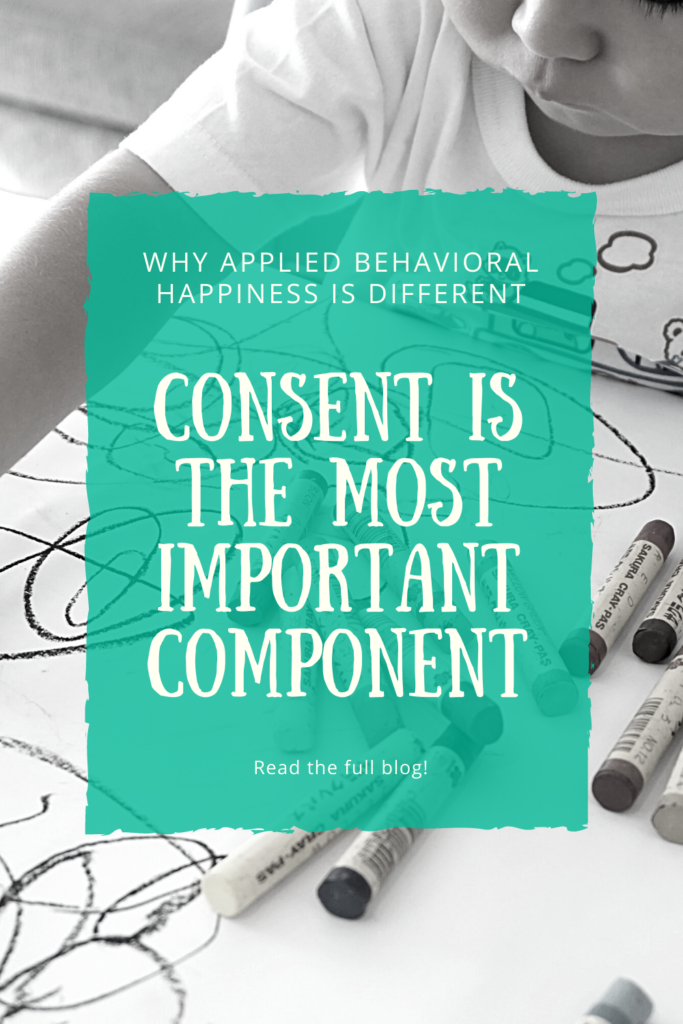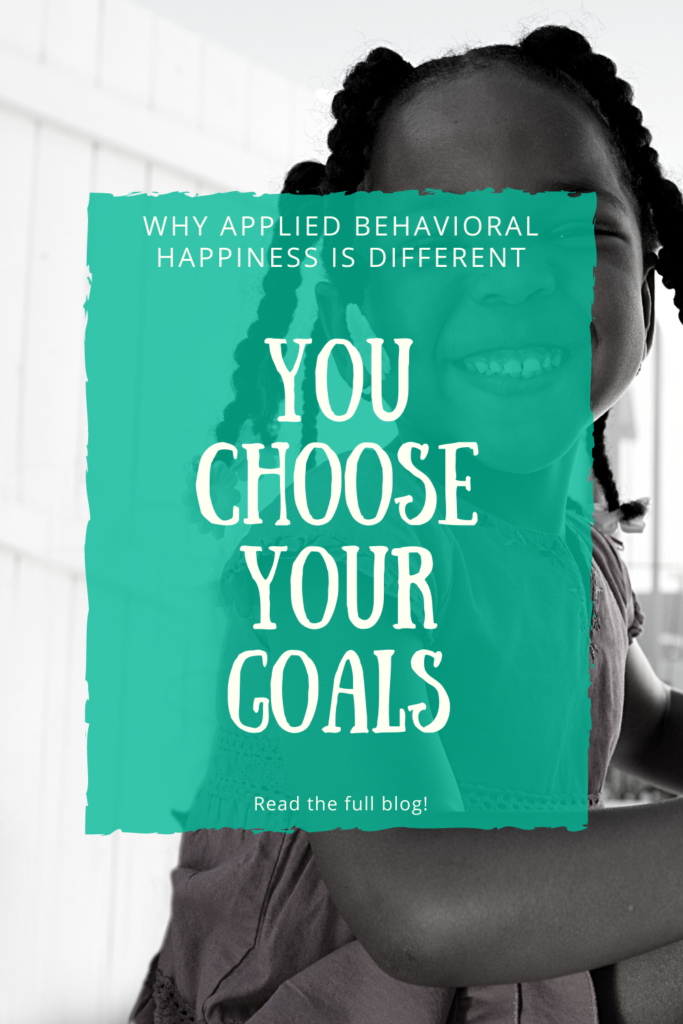ABA is fraught with a lot of controversy, and (frankly) it is in many ways deserved: many people (see: children) have been traumatized by their experiences in ABA. How can a neutral science, a description of how behavior works, have gone so awry? And what is ABH doing to fix it? Here are ten ways that ABH is different than other ABA companies.
Before we start…
We are not the perfect company for everyone. ABA is not the right therapy for everyone (click here to read about ABA Red Flags). You may agree with nothing here or everything and either way, it won’t make you right, wrong, or otherwise. This is where we stand and we respect if you stand somewhere else 🙂
I have added in quick criteria to see if we are a good fit to work with you or not under each of these reasons we are different. Again, you are not right or wrong if we are or aren’t a good fit for you: we aren’t perfect for everyone and that is a-okay.
Reason #1: we don’t treat autism at Applied Behavioral Happiness
At ABH, we do not require any diagnosis to work with us. While most ABA companies work under insurance as their main source of funding (and are thus bound by the rules that insurance poses), ABH provides mostly out-of-pocket services. To see an updated list of our funding options (insurance and grant funding), click here and scroll to the funding section near the bottom.
This means:
- If you want someone to support (not force) your child through making behavioral changes, we may be a good fit.
- If you are looking for someone to treat your child’s autism, we are not a good fit.
Reason #2: we don’t target stimming or eye contact at applied behavioral happiness
There are a number of targets that many ABA companies will target that we simply won’t. The reason we won’t is because we actively listen to people who went through targeted “treatment” of these behaviors, and they overwhelmingly stated that this was not an affirming, but rather a pointedly distressing experience. If at any point there is the slightest sign of distress, we stop.
A behavior change is not worth traumatizing a child, period.
This means:
- If you are looking for help with tantrums, meltdowns, tolerance, flexibility, pivotal skills, phobias, or communication, we may be a good fit.
- If you are looking for someone to stop your child from stimming or to target eye contact, we are not a good fit.

Reason #3: We won’t to take over your daily life at applied behavioral happiness
Our programs are 10hrs per week max (most companies max out at 40hrs of treatment per week) and average around 3hrs per week. It is important that your kid has time to be a kid and that therapy is not their life. As well, other types of therapy may get pushed out of the way if ABA is taking up all of your time, which means you are missing out on the expertise of some amazing professionals.
In fact, part of our assessment is screening for PT, OT, and SLP services to see if working with those professionals as a part of the team would be beneficial. You can find a number of people that we refer to on our Resources page.
At times, we require other professionals to be on the team or for you to work with them before working with us. Other times, it’s our goal to help you and your child access these other therapies and we have done our job when you fade from us and can start up with them. As well, we often take the position of helping organize the team and help keep everyone on the same page.
This also means that we require a lot from the families we work with: if you want in-person services, you will need to go through Crisis Prevention and Intervention Training which is a 4hr course and a year of follow-up meetings (all for a single price, check out our programs page for more information).
We are not going to take your child away and “fix” them because they don’t need fixing: they may need support and guidance, and we can help you with that.
This means:
- If you are looking for support and are willing to make changes to your own behavior and to the environment in order to support changes in your child’s behavior, we may be a good fit.
- If you are looking for many hours of services or for us to work on the behaviors without you involved, we are not a good fit.
Reason #4: applied behavioral happiness won’t be in your life for years
We are set up to come in and support you as much as you need, then fade out. Often, we work with families in person for a few months and then move them into our coaching model with the support of our group Empathetic Behavior Change.
We would rather fade in and out than have you grow 100% dependent on us being in your lives: we are happy to stay involved, but we want to work ourselves out of a job as quickly possible!
This means:
- If you are looking for support to work through some tough things and want to be independent (or just have some basic coaching now and then) as quickly as possible, we may be a good fit.
- If you are looking for many hours of services across many years, we are not a good fit.
Reason #5: consent is always first, second and third at applied behavioral happiness
We want to move forward as quickly as possible at the pace that your child sets. Once we know that they are happy, relaxed, and engaged, we work on making sure they know how to (1) show consent, (2) revoke consent, and (3) advocate for their needs before all else. Steps 1-3 are CONSENT.
We use what is called an Enhanced-Choice Model wherein if a child chooses to work with us on skill building, life is awesome and they get everything they need to be happy, relaxed, and engaged. If they choose not to work with us on skill building, life is STILL awesome and they get everything they need to be happy, relaxed, and engaged.
Kids don’t lose anything for communicating that they aren’t in a place to work on difficult things. We want them to say no. If they can’t set healthy boundaries and if we don’t encourage them to, we are setting them up to be abused and victimized. (If you want more, check this out.)

Our data and the research in the field shows that children will choose to work with us. The choice to make changes and to work on things means that the changes made were done so without duress and are likely to last.
We are so passionate about this topic that we have a workshop and eBook called Learn consent, Teach consent that is targeted to supporting mothers of daughters in stopping generational trauma by learning to set healthy boundaries. It is a life changing workshop and the eBook is an exceptional workbook that can help the whole family.
This means:
- If you describe yourself as a gentle parent, a Montessori parent, an intuitive parent, or in any other way that emphasizes the child’s right to express and revoke consent, we may be a good fit.
- If you want us to have a “my way or the highway, kid–do it or else” attitude when working with your child, we are not a good fit.
Reason #6: we don’t advocate for ignoring children at applied behavioral happiness
We are not going to pretend your child doesn’t exist when they do something that we “don’t like” because ignoring causes several things to happen: (1) it assumes that shame or discomfort will teach a skill, (2) it decreases the connection between adults and children, and (3) it usually will make behavior worse in the short-term, which can be unsafe for everyone.
There are times when we ignore a behavior. If a child says “Hey Ms Kellie, you’re a pooper scooper!” (and yes this is a real life example), I may not respond to that. I may provide an alternative (You can call me a Super Scooper if you would like) and redirect but I will not, and my staff will not, ignore the child.
This means:
- If you are cool with ignoring behavior and redirecting but not ignoring your child, we may be a good fit.
- If you are set on using ignoring, we are not a good fit.
Reason #7: we use little to no physical prompting at applied behavioral happiness
Because we are a consent-based company, we aren’t going to be coming in and providing a ton of physical prompting all the time. We don’t want to invade your child’s space as that would be rude and disrespectful to them.
If my staff had to physically manage someone, they cannot be in contact with them for longer than 60 seconds (strict company policy), and this could only be used if all other safety measures have been exhausted. Because we never force kids to do anything, we rarely see intense behavior and if we do, we simply support the child through the moment.
We would rather reinforce a challenging behavior and take the time later to figure out a more healthful plan of action than escalate a child to the point of crisis.
This also means that we take a strong stance on bodily autonomy (see: consent, above) and corporal punishment. In North Carolina, corporal punishment is allowed and there are a lot of cultural pieces to how parents choose to discipline their children. I will never shame a family for their choices.
At the same time, I want to be sure that you know we take a strong stance against corporal punishment as a company.
Here is how I explain it: if I wouldn’t do it to my best friend, I will never advocate doing it to a child.
Many families come to us because they wish to no longer use corporal punishment but they don’t know what else to do. Everything else has failed them and this is all they have left OR this is what they know and what they grew up with and they do not see any good alternatives. If you fall in this category, know that you will not be shamed and will be welcomed with open arms: we are here to help!
This means:
- If you want a company that respects your child’s right to not be touched, we may be a good fit.
- If you are looking for a company that will regularly physically manage your child or if you are set on using corporal punishment as a part of your discipline strategy, we are not a good fit.
Reason #8: We have low-cost options at applied behavioral happiness
Our Empathetic Behavior Change membership is set at an super affordable rate so that everyone can access support. Sure, we could make everything cost hundreds of dollars an hour: my staff are more than worth it. They engage in constant continuing education, have high level degrees, and go through hours of additional training every year.
But that would make our services unavailable to too many people. It would make money the gatekeeper of support. That’s not something we are willing to live with, so we always have no-cost and low-cost options. Many companies do not have low-cost options or won’t take the time to help you get funding. That doesn’t make them bad, it’s just a different model. We want to be something different for the community.
This means:
- If you want support at a price you can afford, we may be a good fit.
- If you are want to work with a company that focuses on working with only certain populations or socioeconomic status, we are not a good fit.
Reason #9: We let you choose your goals at applied behavioral happiness
Because our model focuses on what matters most to you (not what insurance likes to pay for or what a curriculum says should matter to you), we are able to have increased flexibility with our programs. This means that you get a bigger say in the goals and programs than you may get with other ABA companies.
When we are working with families, we often will program CABs or “contextually-appropriate behaviors” that are based off of your exact goals. If your child has trouble with transitions, our CABS will revolve around different types of transitions. If you have a really hard time keeping things rolling through daily routines (getting to school, doing homework, going to bed, etc.) then our CABS will revolve around the routines in your life. If your child has trouble being independent in daily living tasks, the our CABS will focus on specific tasks that will help them gain more independence.
Generally, we don’t have classic ABA programs like matching colors, arbitrary imitation (touch head!), or random waiting goals (you have to wait 3mins) because while these are skills that can be useful, they generally do not make a huge difference in a family’s life. These skills may be mixed into what we do (example: it’s time to put all the blue toys in the blue bin), but we won’t generally target them directly.

This means:
- If you have specific, clear goals that you want to work on, we may be a good fit.
- If you don’t know what your goals are (and don’t want to have specific goals) or just generally want ABA because it’s what you feel your child needs, we are not a good fit.
Reason #10: We refer out more families than we take on at applied behavioral happiness
Applied Behavioral Happiness is a for-profit business so why would we refer out more families than we take on??? See: items 1-9 of this list and check out our Resources page to see some of our referral partners. Because we are such a different company, we are not the right fit for everyone.
Many families hear about the amazing results that we help have parent’s achieve, see the reviews from other providers, or get a taste for what we do from one of our free or low-cost programs and want to work with us! The thing is, they don’t actually want what we provide and that’s okay; you can want the results and find that the provider isn’t the right fit. When we find this, we refer out.
We make a lot of referrals to other types of support includes social workers, psychologists, family therapists, physical therapists, occupational therapists, speech language pathologists, and more. We even make referrals to other ABA companies if we don’t cover a family’s insurance or if they are looking for something that we don’t provide.
This means:
- If all or most of what we have talked about here fits you, we may be a good fit.
- If you want something different than what we provide, we are not a good fit and that’s okay! We will help you find the right fit for you 🙂
Do you want to keep up with the latest ABH goodness? Sign up for our weekly email and we will send you free tips, tricks, and resources (as well as deals and program updates). Plus, you’ll get a free gift!
